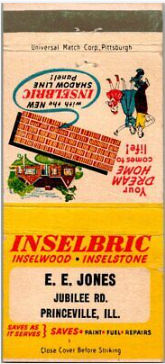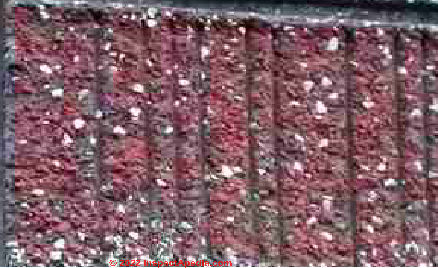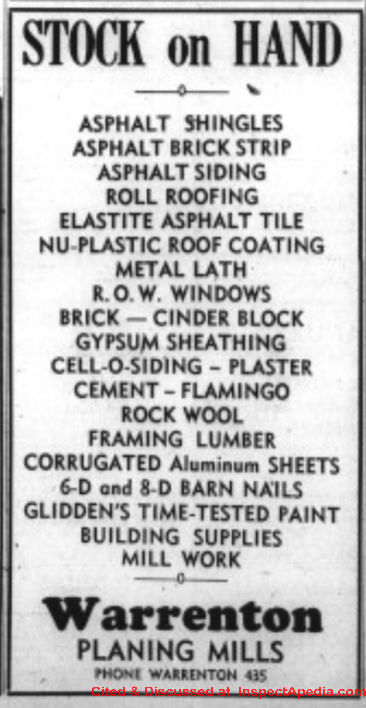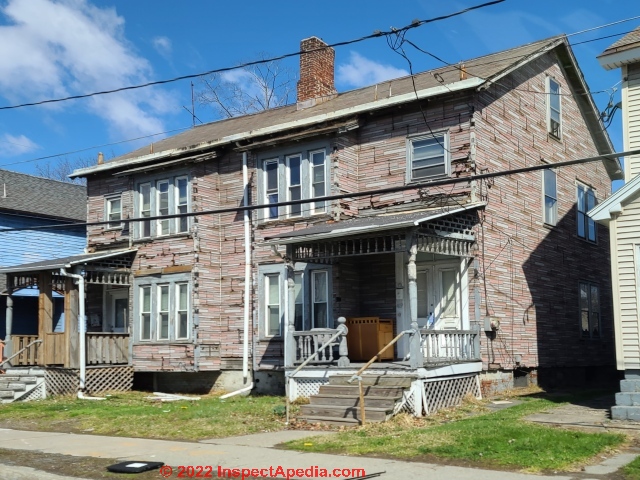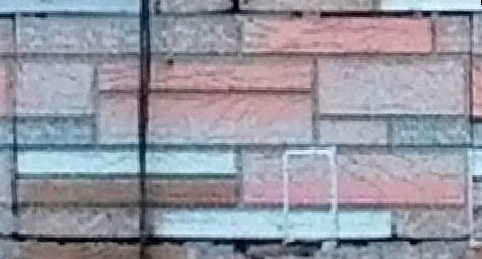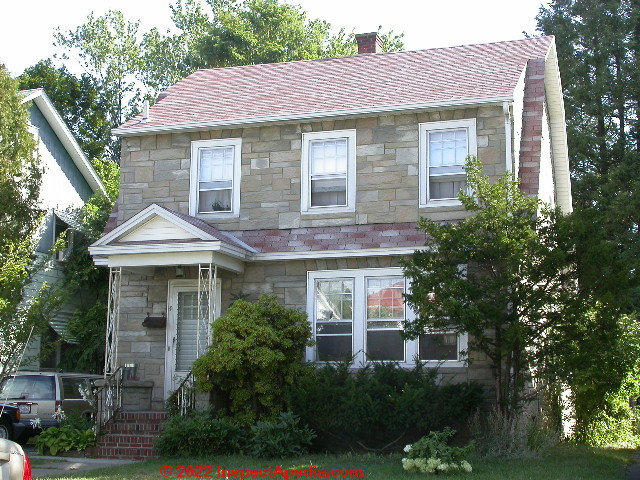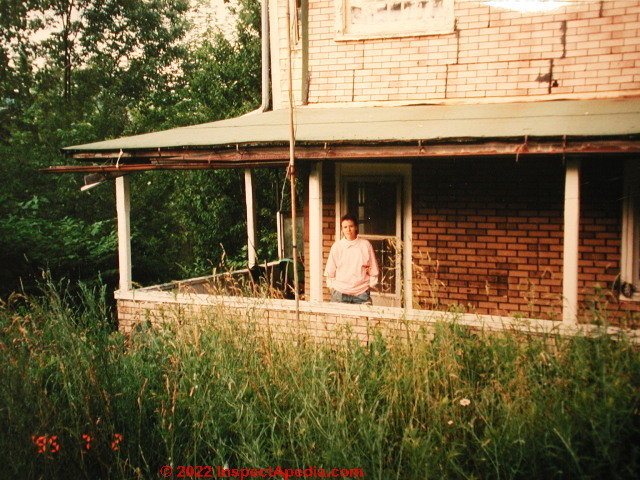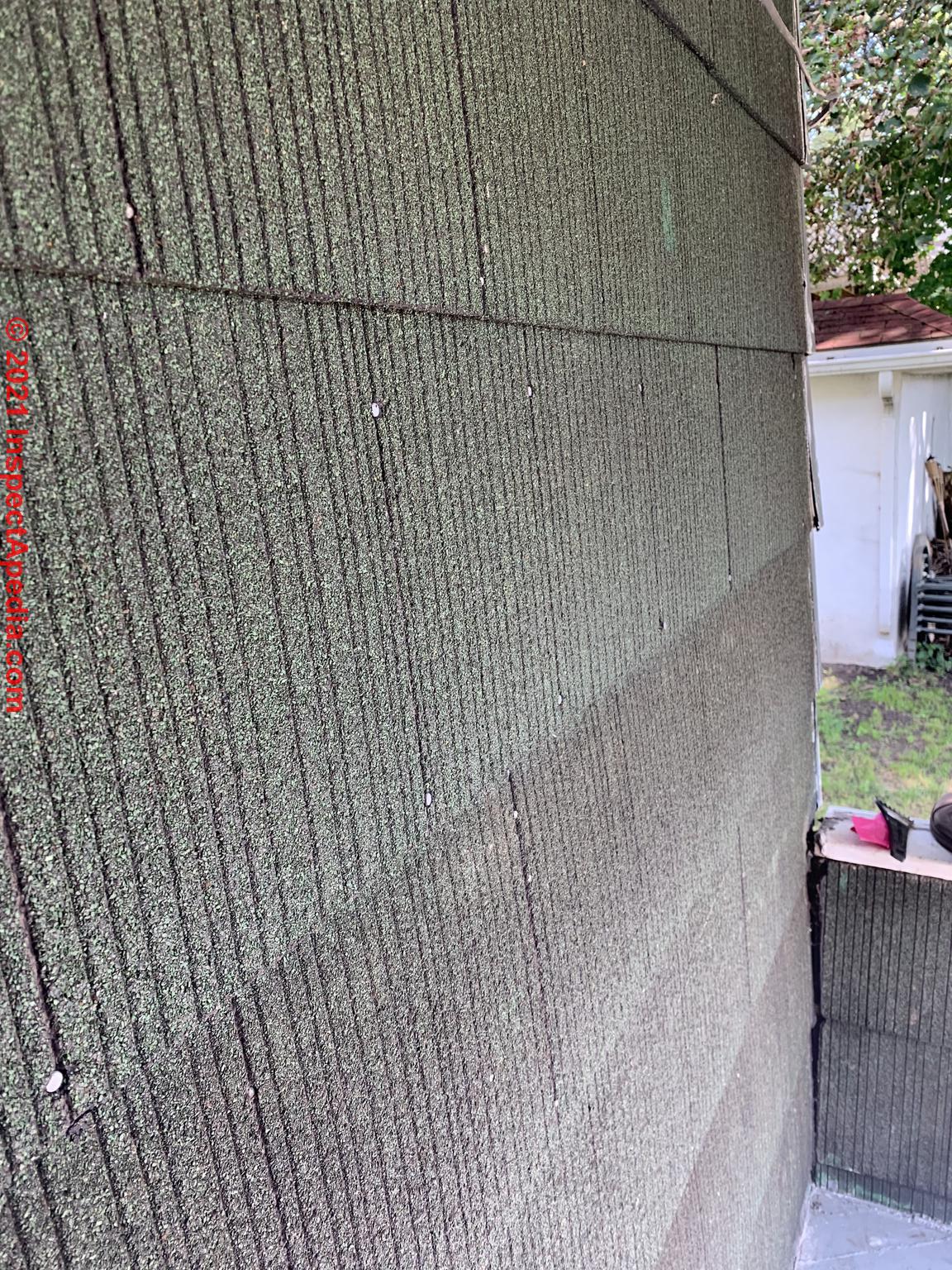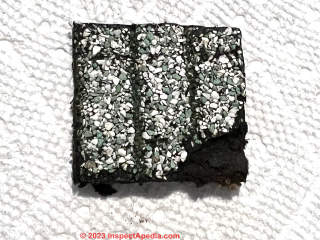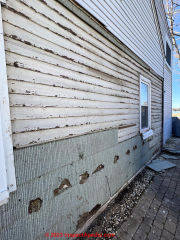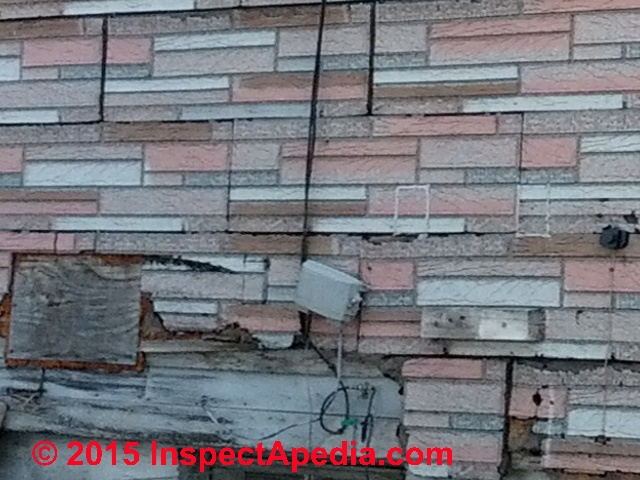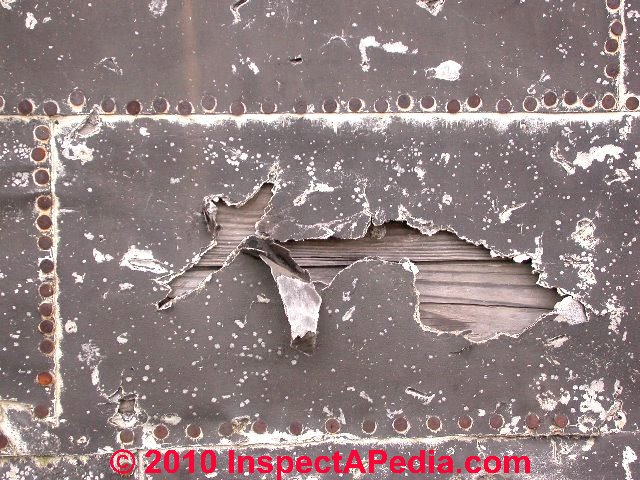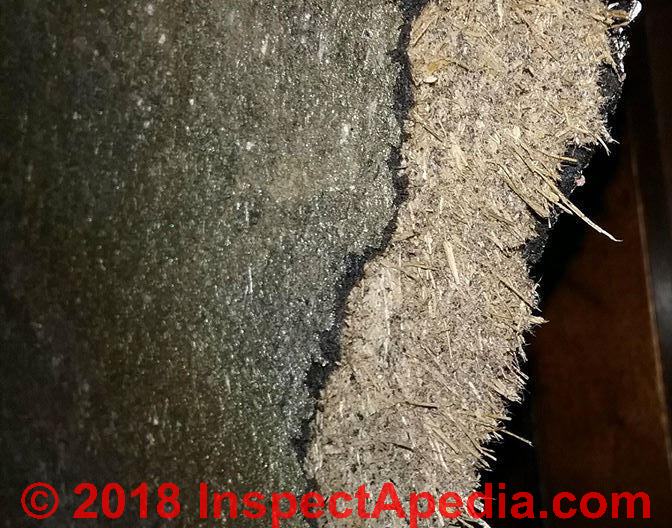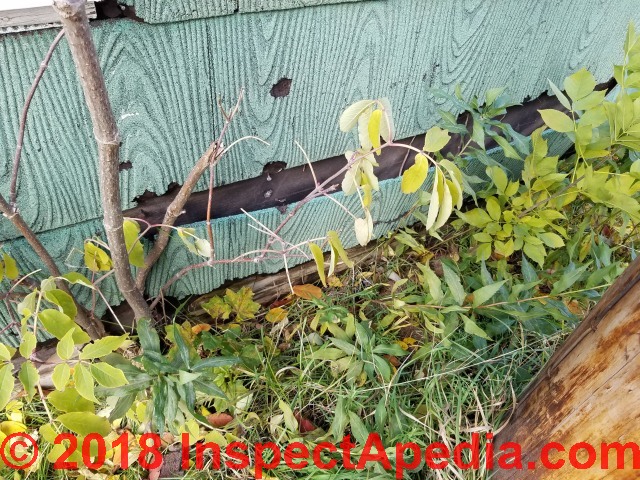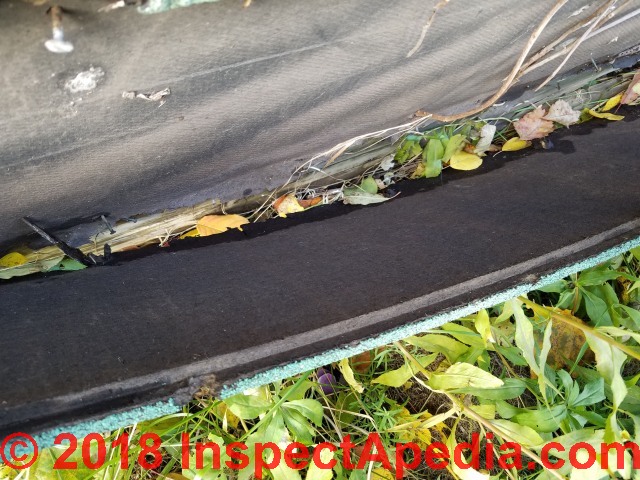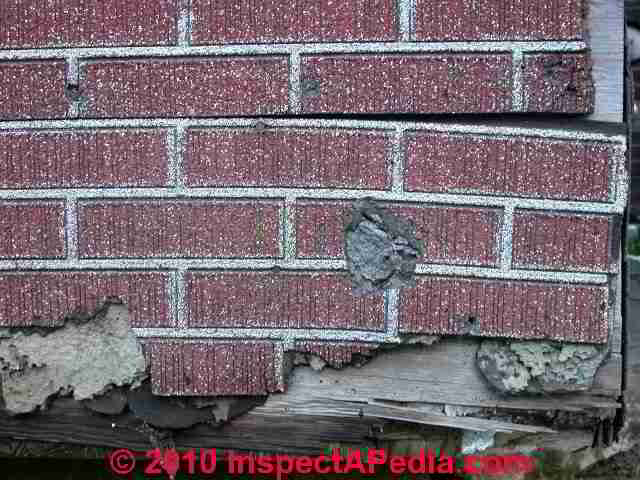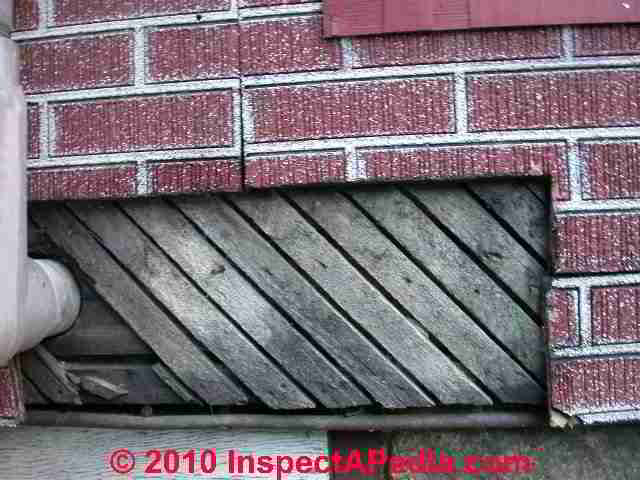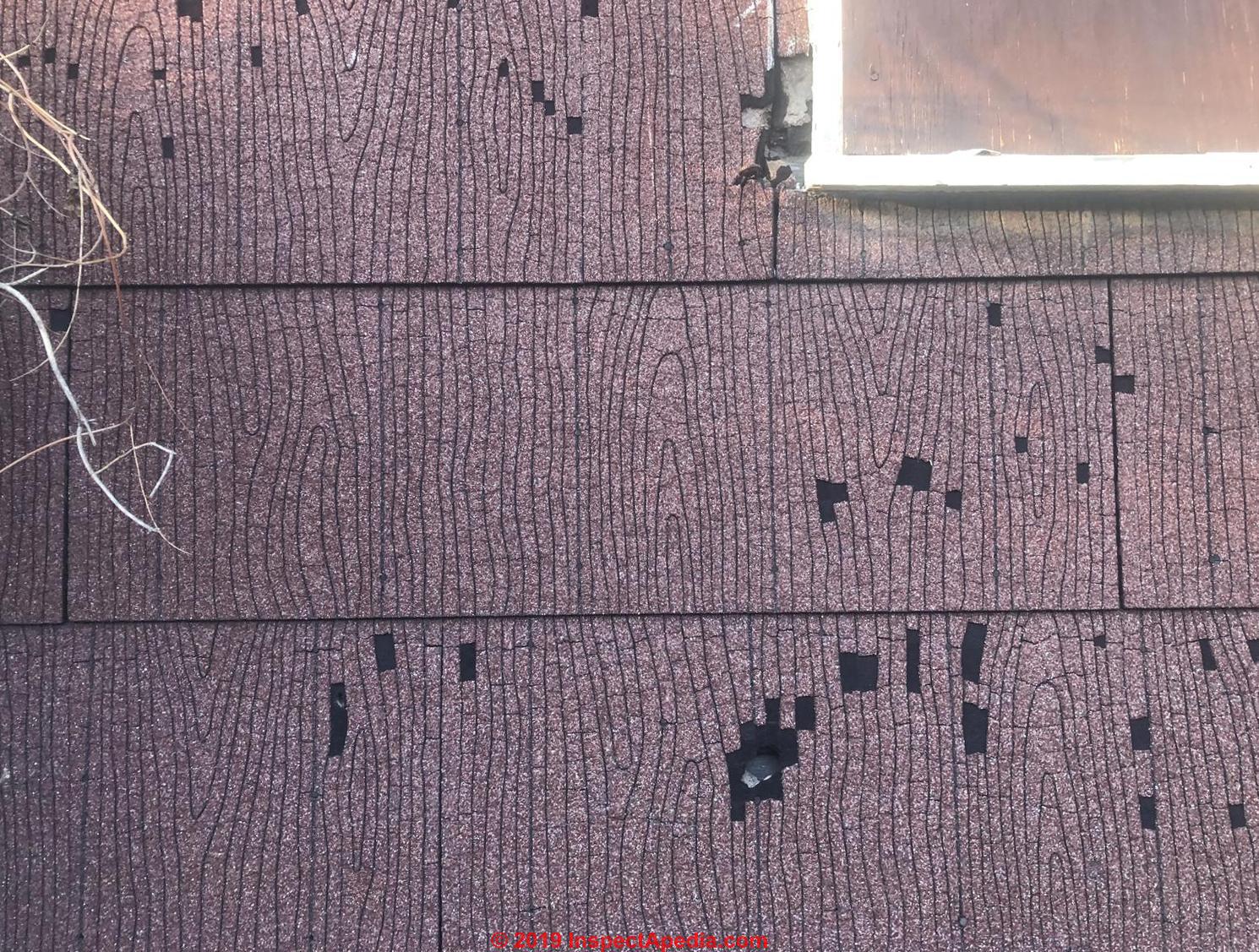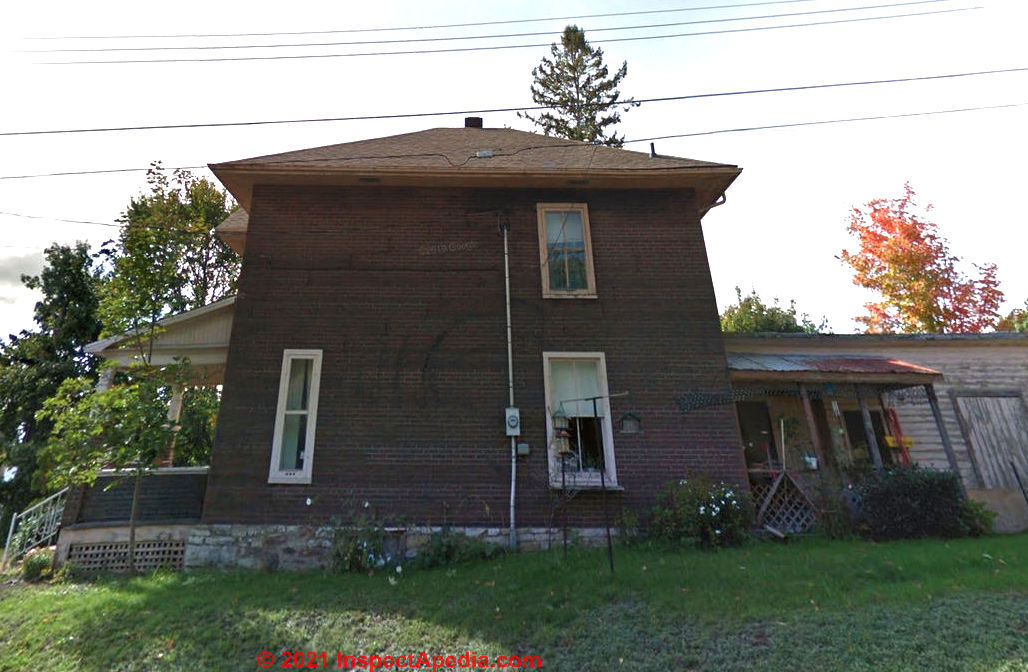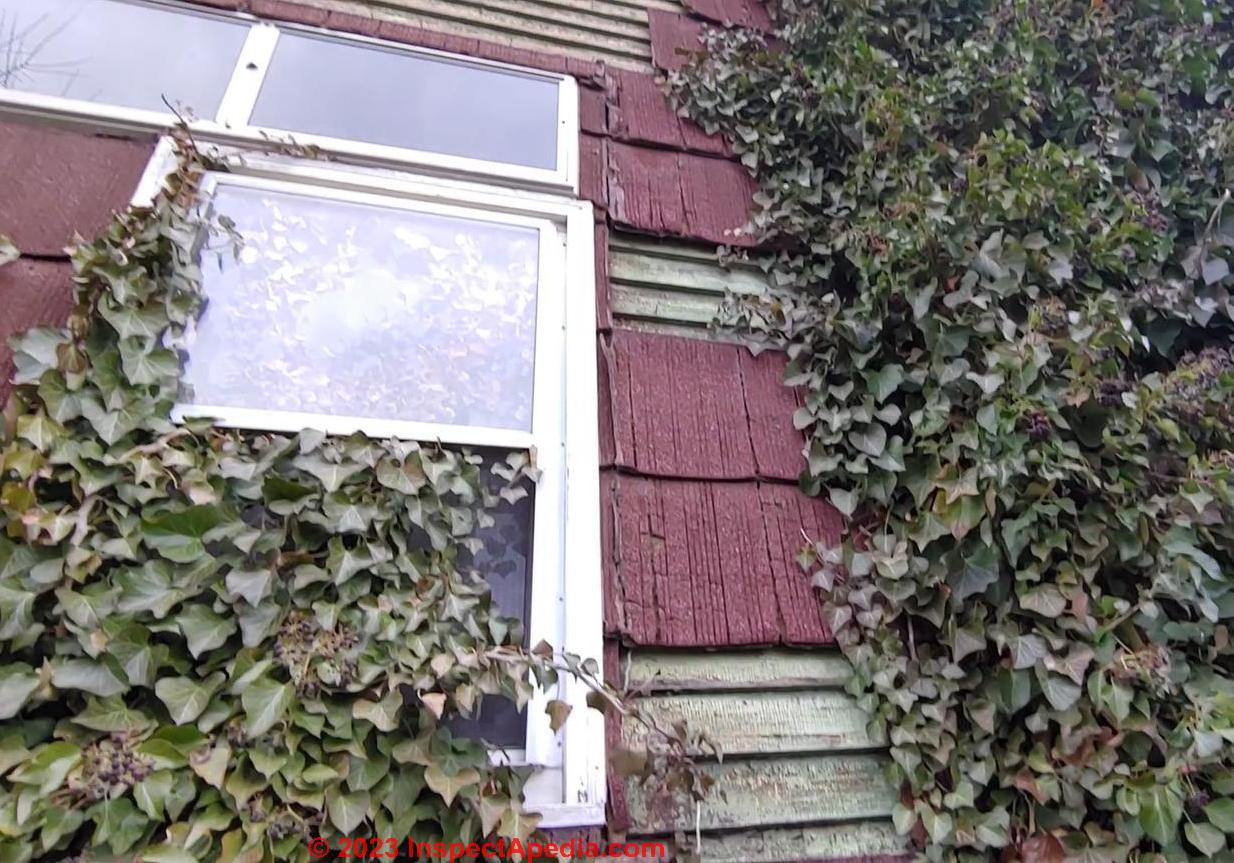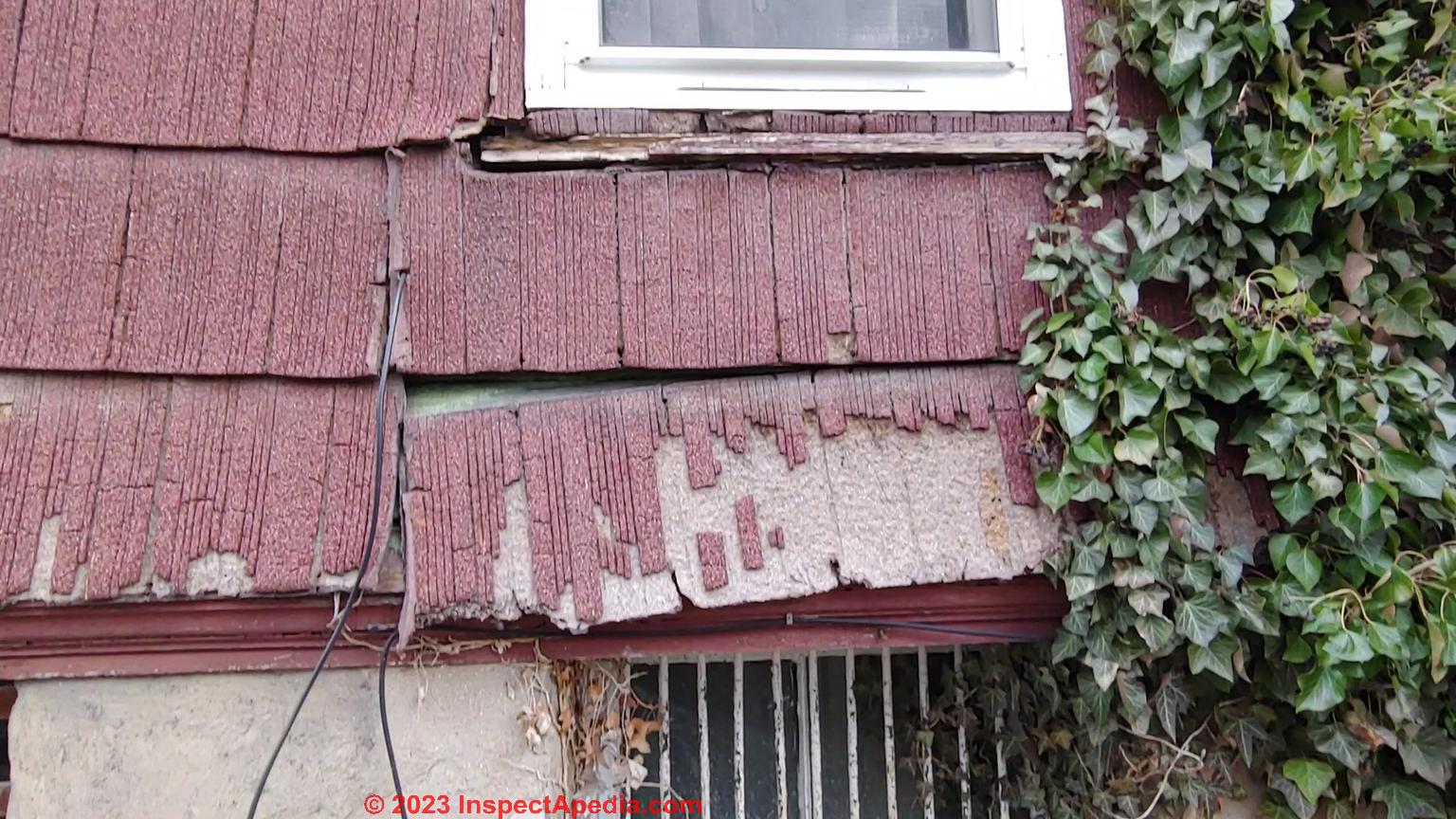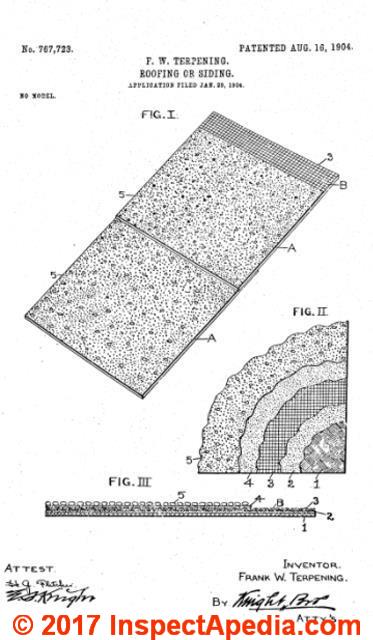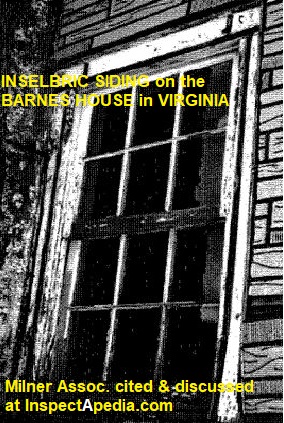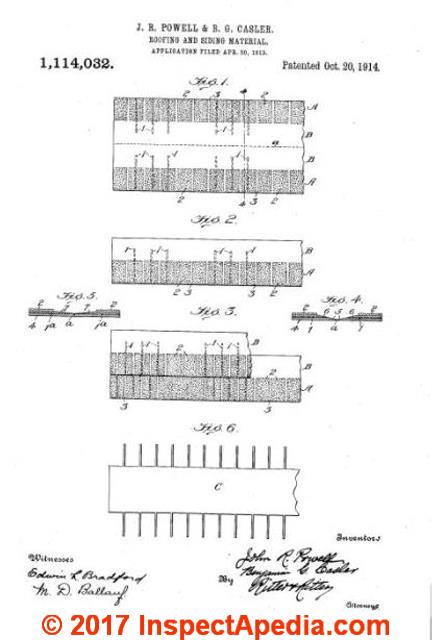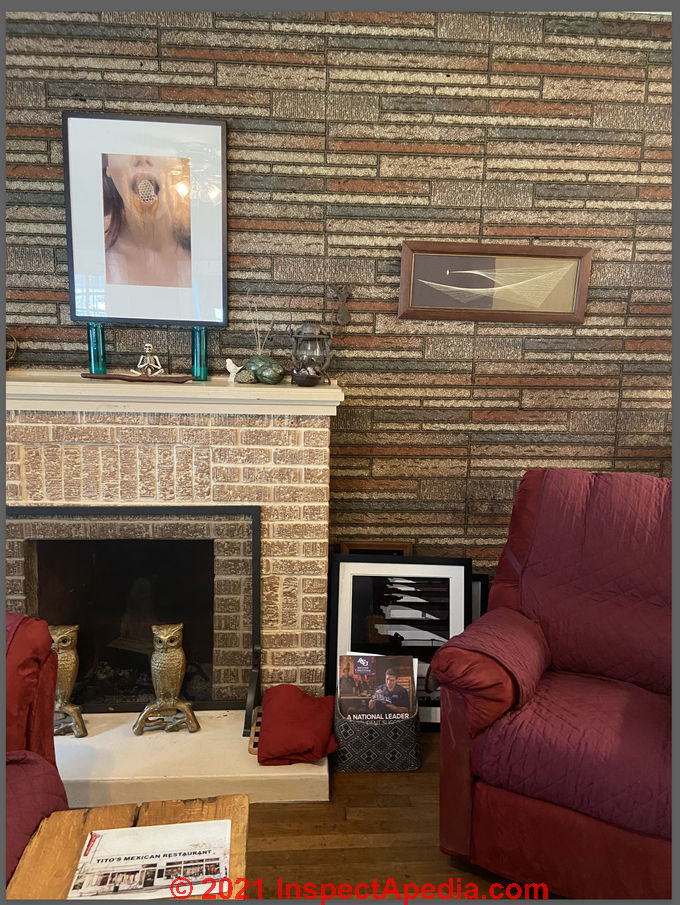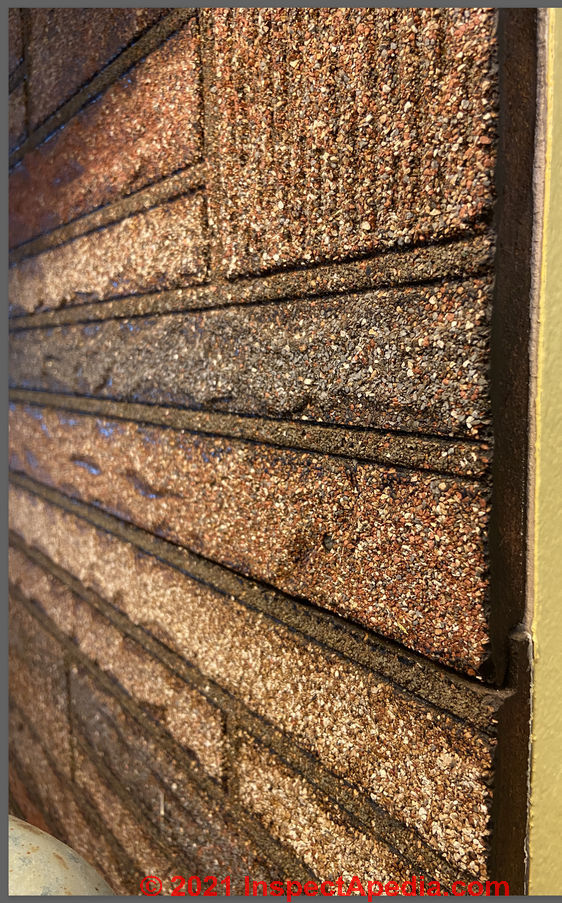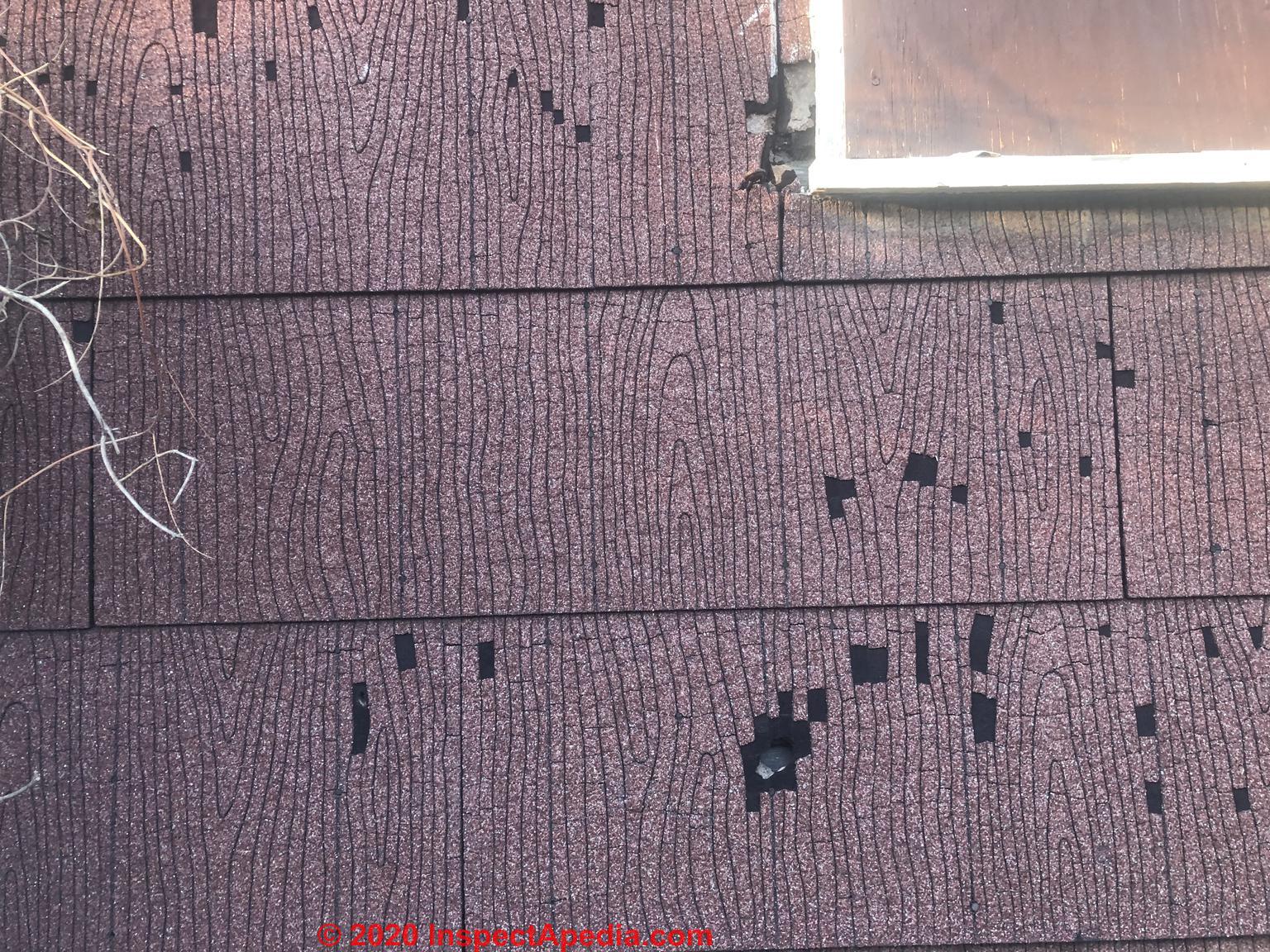 Asphalt Shingle & Sheet Siding
Asphalt Shingle & Sheet Siding
History, patterns, materials, inspection, repair, replacement of asphalt siding
- POST a QUESTION or COMMENT about asphalt-based building siding products
Asphalt siding history, patterns, inspection, repair, replacement and ingredients.
Does asphalt siding contain asbestos? Is that dangerous?
Asphalt building siding was installed as shingles or as larger sheets or rectangles, sometimes bonded to a hardboard backer.
This article provides photographs of asphalt-based siding products and discusses common defects observed in asphalt exterior building siding, such as buckling, splitting, cracks, odors, and questions about the need for a vapor barrier behind asphalt siding and over building sheathing.
Included are comments from several recognized building inspection and construction authorities. Between 1980 and 2000, author renovated and repaired older homes like the ones shown on this page.
InspectAPedia tolerates no conflicts of interest. We have no relationship with advertisers, products, or services discussed at this website.
- Daniel Friedman, Publisher/Editor/Author - See WHO ARE WE?
Asphalt Siding Concerns, Defects, Vapor Barriers, Inspection, and Diagnosis
 Asphalt building siding became a popular building renovation alternative to painting weathered or rotted wood clapboard or wood shingle siding as early as the 1930's, becoming popular in the 1940's and the 1950's in North America where it was used both for low-cost housing and for covering the deteriorated exterior walls of older homes.
Asphalt building siding became a popular building renovation alternative to painting weathered or rotted wood clapboard or wood shingle siding as early as the 1930's, becoming popular in the 1940's and the 1950's in North America where it was used both for low-cost housing and for covering the deteriorated exterior walls of older homes.
Asphalt building siding products are typically composed of asphalt shingle-like material: colored mineral granules bonded to an organic or wood-product base with asphalt.
Colored mineral granules form a desired pattern such as the faux red brick asphalt siding shown here in two different designs on an elderly building in White River, Vermont:
a red brick with white mortar joints asphalt siding on the building front (left side of photo), and
a very worn red brick with gray-tan mortar joints asphalt siding shown on the building side wall (right side of photo).
Here we provide identification photos of several types of asphalt-based building siding and we list asphalt-sided building inspection, diagnosis, and repair suggestions.
We discuss asphalt siding damage, defects, and repairs, asphalt siding installation defects and its effect as a vapor barrier on the exterior wall of a building. We also discuss asphalt siding leaks and rot risks.
We include a brief history of the development, patterns, brands and colors of faux brick and faux stone siding, offering clues ab out what is probably underneath it.
We also review the possible asbestos content in this asphalt-impregnated felt product, and finally we address a common question: can I use asphalt roofing shingles as building siding?
Article Contents
- ASPHALT SIDING HISTORY, DATES, NAMES
- ASPHALT SIDING IDENTIFICATION KEY
- ASPHALT SHEET SIDING PROPERTIES
- ASPHALT SIDING CONTAINS ASBESTOS?
- ASPHALT SIDING BACKER CONSTITUENTS
- ASPHALT SIDING DEFECT CHECKLIST
- ASPHALT SIDING REPAIR, COVER OVER?
- ASPHALT SIDING HISTORY & PATENT RESEARCH
Our page top photo shows an asphalt shingle sided home located in Two Harbors, Minnesota. If you click to enlarge the picture you'll see that an apparent asphalt siding repair was made above the second floor windows.
Our Coolidge Hotel photo shows (above-left) shows that the material can also be quite durable if properly installed and weather protected. [Click to enlarge any image]
History of Asphalt Building Siding
 Asphalt-impregnated felt material similar to roof shingles or asphalt-impregnated felt bonded to hardboard or to insulating board was discussed as a building siding material in the U.S. as early as 1904 (Terpening 1904).
Asphalt-impregnated felt material similar to roof shingles or asphalt-impregnated felt bonded to hardboard or to insulating board was discussed as a building siding material in the U.S. as early as 1904 (Terpening 1904).
Photo just above: an InselBric asphalt sided home in Poughkeepsie, New York, photographed in 2015.
In additional photos of this home (below on this page) you'll see accelerating wear and damage to the siding on this home and finally, in 2024, a major renovation project underway.
1840 - Asphalt-impregnated materials had been in use in a variety of forms for hundreds of years and had been in wide use in roofing in North America in an earlier formulation since the 1840s when the predecessor of asphalt shingles and siding was first sold: a mixture of fabrics covered with pine tar and sand.
1903 - hose early products were succeeded in 1903 by shingles cut from rolls of felt (basically thick paper) saturated with asphalt and coated with mineral or ceramic granules to create a durable and sun-resistant surface.
1914 - Asphalt-based siding resembling bricks was described by 1914 (Powell 1914) and further developed by Welty (1924).
1918 - chipped slate coated asphalt roll roofing was proposed for use on the gable ends of a house to replace stucco and to give a half-timbered image (Parker 1918 in Arkansas 2017).
1929 - or earlier: hexagonal shaped mineral-granule coated roof shingles were marketed as a wall covering, possibly promoted in an effort to sell unused roof shingles during the Great Depression when many homeowners put off roofing repairs.
The use of asphalt roofing-like materials as building siding no doubt grew out of the combination of unsold asphalt roofing during the Great Depression in the U.S. and the lack of maintenance on homes during that period that left a need for an economical wall re-covering material.
1930 - Asphalt building siding became a popular building renovation alternative to painting weathered or rotted wood clapboard or wood shingle siding as early as the 1930's, becoming popular in the 1940's
1931 - Both Certain-Teed & Johns-Manville sold asphalt-strip shingle material in a red (or gray or green) brick pattern installed with a 2 1/2" exposure.
Above and below: Inselbric advertisements from the 1940s (Life Magazine) and 1950s (on a matchbook cover for sale on eBay in 2022).
Later Celotex produced Insulbrick siding, and adding confusion to these product names, Insul-Brick from Westblock Products, produced in the U.S. in the 1980s, is a completely different material - an insulating brick made from perlite, not a siding product.
1932 - InselBric Asphalt Siding - asphalt-siding but did not become widely popular in North America until the 1930's when the Mastic Corporation (South Bend, Indiana) began marketing InselBric in 1932, (also written Inselbrick and mis-spelled as Insulbrick or Insul-Brick) asphalt-based faux-brick siding panels. Inselbric is also described as rolled asphalt siding.
1935 - Inselbric formed 100% of the Mastic Corporation's sales in the form of brick panels. Other asphalt shingle material sold for use as "siding" included hexagons, pyramids, and faux stone, usually in red, green or tan or gray.
1937 - Sears Roebuck catalog included brick-pattern "insulating" wall panels sold in 14" x 43" sections (5 "courses" of bricks). Sears faux-brick siding colors included brown tone, red tone, jade green, and tile red.
1940 - improvements in asphalt siding production machinery permitted pressing embossed designs into the granule-covered asphalt siding surface sold under a variety of brands including "Brick Strip" or "BrickTex" exterior siding. (Example above.)
Beginning in 1929 Sears sold brick veneer kit homes in the Honor-Bilt series - see details
at SEARS KIT HOME IDENTIFICATION
But asphalt-based siding from Sears did not appear until eleven years later, in 1940, when Sears introduced a substitute for actual brick veneer: Honor Bilt Brick Roll-Type siding.
This asphalt siding was produced in 32" x 43’ sections, as a new addition to Sears' four brick double lap siding that had first been marketed by the company three years earlier in both roll type and rigid type asphalt siding in brick patterns as a low-cost and durable building renovation material.
1941 - Sears added Honor Bilt Brick Roll Siding in larger 32" x 43" sections.
1943 - Asphalt based random stone pattern siding was developed and sold in a random stone pattern as early as 1943 when Sears produced gray Inselstone (Ashlar stone in some references).
1947 - Asphalt based Brick-Strip siding was sold in this "Stock on Hand" advertisement that appeared in the Virginia Star, Vol. 28 No. 9, on 23 January 1947 (when the author was 5 years old). Brick Strip siding was also used to cover building elements such as columns and pilasters, often used on storefronts as well as residential buildings.
We found reports of re-siding buildings using brick strip, as a generic term, in historic documents such as ten separate buildings described in "Fredericksburg, Virginia Permits to Alter or Repair 1938 to 1946 sorted by Street" - retrieved 2023/11/30 original source: resources.umwhisp.org/Fredericksburg/building_permits/permits to alter_1938-1946.htm
Also see 1931 for our description of insulbrick on this page.
1950's - in North America where it was used both for low-cost housing and for covering the deteriorated exterior walls of older homes.
Above: the same asphalt sided InsulBrick home on the East-West Arterial in Poughkeepsie, New York as shown at the start of this article, here as it was seen again in 2022. Once openings appear in any building siding material the deterioration of the building accelerates.
Below: finally, in July 2024, we see that the asphalt siding is badly deteriorated, the home is unoccupied, but we were also grateful to see that it is undergoing major renovations, as evident by the replacement windows being installed.
The owner is repairing this home in time to save it from falling into a state of beyond economical repair, thus providing badly needed housing in Poughkeepsie.

Notice that the owner is changing those front windows from triple sets to double window sets, probably admitting more light to the interior.
1954 - Sears added Ranch Stone, an asphalt shingle siding pattern resembling stone. Colored random stone pattern siding like that shown just above (Poughkeepsie, NY) was sold beginning in 1954, sold as Ranch Stone patterned asphalt siding.
1966 - Sears Roebuck added Random Stone asphalt-based siding (one panel shown above), a stone siding pattern with "wire cut bricks" inserted into the pattern.
Asphalt siding material was made in two common versions, one much like asphalt roof shingles but in larger sheets (right-side of the building photo near the top of this article) and the other was comprised of an asphalt coating laminated to hardboard siding material or laminated to a softer wood-based insulating board panel, often sold as "InselBrick" or "InselStone" siding depending on the manufacturer and pattern.
Sears Random Stone siding used the fiberboard-backed design rather than thin asphalt-impregnated felt.
Commonly made to look like brick (faux brick), asphalt building siding also appears in faux-stone versions (not to be mistaken for "perma stone" which has been sold since the 1960's as an exterior wall covering) and even in a wood-shingle lookalike, as well as a utilitarian covering that was unabashedly plain asphalt sheeting.
PermaStone & Aluminum Siding Replaced Asphalt-Shingle-based siding
The development of the aluminum siding industry (introduced in the 1940's) and later the vinyl siding industry after World War II meant that fewer buildings of that later era were covered with asphalt shingle or slab material and by the 1960s aluminum siding pretty-much ended the asphalt-shingle-based siding industry.
Below: don't confuse other faux stone siding such as "Permastone" with asphalt based siding. Permastone is not asphalt-based.
This house, on Fountain Place in Poughkeepsie, New York, is described separately
Asphalt Siding Identification Key
Asphalt based exterior siding is easy to identify. Here we'll give a basic identification key. You should also look through the siding photographs beginning
at SIDING ASPHALT SHINGLE or SHEET
Below, in the format of reader Q&A we'll include additional photo examples.
- Mineral granule coated surface (shown above)
All of these siding products use a surface made of mineral granules of various colors and either as a continuous homogeneous or "smooth" surface or embossed in patterns to resemble brick, stone, wood, or other surfaces.
Above: Barbara Joy Whan helped us find this building with 2'x4' sections of asphalt shingle siding photographed by the author (DF) in upstate New York in 1995.
Even from a distance we can see the regular rectangular sections of this asphalt based building siding, and at the section edges as well as where it's damaged, we can see black asphalt. Even without getting out of your car you can easily identify this material.
- Asphalt (black) impregnated paper or felt backing (shown above)
Compare your building siding to the photos on this page, noticing the patterns, size and shape of individual siding pieces, and particularly, where you see a chip, break or damage, look for a black asphalt-impregnated paper or "felt" layer onto which the siding's mineral granule surface was bonded.
- Brown wood fiber or fiberboard backing (some products) (shown above)
Some asphalt siding products were bonded in turn to fiberboard or hardboard, so the back of your siding sections may be comprised of brown or tan woody fibers. - Building age and if known, siding age. Earliest use: 1840, most-widely used: 1930 - 1960
Asphalt-based exterior siding (occasionally found indoors as well) was installed on homes in most countries between the late 1930s and the early 1960s.
More Examples of Identifying asphalt-based building siding
The reader asphalt siding Q&A photos below give additional examples of this popular material.
Is this asphalt asbestos siding?
Can anyone help me identify this siding? - On 2021-09-15 by funkymusic14 -
Reply by Inspectapedia Com Moderator
@funkymusic14,
That looks like an asphalt-based siding product like those described on the page above .
Can You Identify this as asphalt siding?
Asphalt siding? On our lake home in Waterford MI built 1936. Discovered under the vinyl siding and a thin foam board. See pic. - On 2023-01-21 by Lorrie -
and
Reply by InspectApedia Publisher - Yes, that's asphalt siding - your photos show two different patterns
@Lorrie,
Yes, that looks like a brick pattern asphalt siding, in more than one pattern; your first sample looks like faux brick.You provided us later with second phto of the building exterior that looks like a different pattern, simiar to ones shown above on this page.
What's under the asphalt siding? Wood clapboards?And yes, we can see the layers of different siding that the house has endured.
Asphalt Sheet Siding Properties & Pictures
The example of asphalt sheet siding in a red brick pattern shown in our photo above is from the Coolidge Hotel, White River Junction, VT.
The random stone asphalt building siding shown just below is based on a hardboard substrate and is quite rigid when installed.
It would be rare to find asphalt-based exterior siding material as original wall cladding on a building; usually it was applied over wood clapboards which in turn were badly in need of paint or repair.
The asphalt-sided home shown just above, located in Poughkeepsie, New York, illustrates the usual wear pattern: the faux-stone pattern asphalt panels weather at their edges where leaks ultimately begin.
At above right at the center of the photo at the bottom of the asphalt-panel siding you can see the original clapboard siding on this home. The house was probably built before 1900.
Above you can see more details of wear, actual loss of hardboard-backed asphalt siding panels, attempts at repair by nailing up a plywood panel, and also rotted wood siding.
Watch out: Don't mistake mineral-granule-covered roll roofing that may have been nailed-up on a building wall for an asphalt siding product. Roofing products were not usually designed for use on a vertical surface and are likely to be found falling off unless extra nails were used.
You can easily spot roll roofing on a building because of its length - you will find long horizontal runs, perhaps 15 feet or more (rarely vertical) without seams.
As we show in our ASPHALT SIDING DEFECT CHECKLIST photographs (below), leaks into this exterior wall covering or mechanical damage to it can expose the hardboard or wood-product substrate to weathering and disintegration.
Just below we provide photographs of a thin asphalt exterior wall covering found on a building in Hudson, NY. This asphalt wall shingle product appeared to have no mineral granule coating whatsoever.
Notice that the stunning number of roofing nails used to affix this exterior asphalt cladding did not make much difference in how the wall covering endured.
Does Old Asphalt Building Siding Contain Asbestos
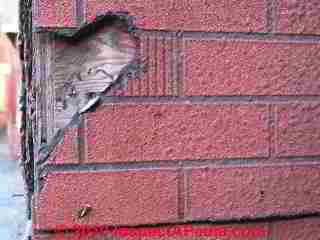 Is the Brick looking asphalt siding ever contained any asbestos or hazardous material.
Is the Brick looking asphalt siding ever contained any asbestos or hazardous material.
I need to remove some of this product but will use a knife to cut it into pieces and bag it appropriately. Also i am having a room demo that is 20x38 and the drywall joint compound is suspected to have chrysotile asbestos contained.
I have taken appropriate measures and have sealed of the area with 6mil poly and taped the joints.
Should this upon removal be sprayed with water or are the asbestos crystals encapsulated in joint compound. Have you come across this situation. Thank-You. D.T., Canada
(July 21, 2012) Kent W. Roeser said:
I have asphalt faux brick Finnish shingles on the back of my house how can I tell if they are asbestos? The house was built in 1920 and the addition was later on. The owner said they were asbestos but with the seizures his memory is not there.
Reply: Maybe. Some does.
A competent onsite inspection by an expert might confirm the age and type of this particular asphalt-siding product, and also, based on the probable building age, it is certainly possible that other asbestos-containing materials are present. That said, here are some things to consider:
In general I think you are referring to an asphalt product that is made essentially of the same material as asphalt roof shingles, though some versions applied bituminous and asphalt and mineral granules to a hardboard base rather than a paper ("organic") base.
Some asphalt roof shingle products, and therefore quite possibly some asphalt siding products, did indeed contain asbestos fibers in their substrate or coating.
Roof shingles, even if the material contained asbestos (which it might) are rarely the only nor even the principal source of problem-levels of asbestos fibers in a building and I suspect the same is true of asphalt-based building siding. That's because the asbestos fibers are encapsulated in asphalt or similar non-friable bases.
There might be a concern if building demolition is underway and the removal of old siding created dust - especially if power tools such as power saws or grinders were used.
Watch out: if that's going on with your building it would be prudent to use appropriate dust control measures and to minimize the break-up of the material, and especially, to avoid using power saws. And there may be provincial or local municipal regulations that govern the demolition and removal of these materials.
Kent some old asphalt roofing and siding materials contained asbestos but to know for sure you'd need to send a small sample to a certified asbestos testing lab. If you can send me some photos I can comment further.
Swedish asphalt siding asbestos? What about Swedish yellow or red faux brick asphalt siding?
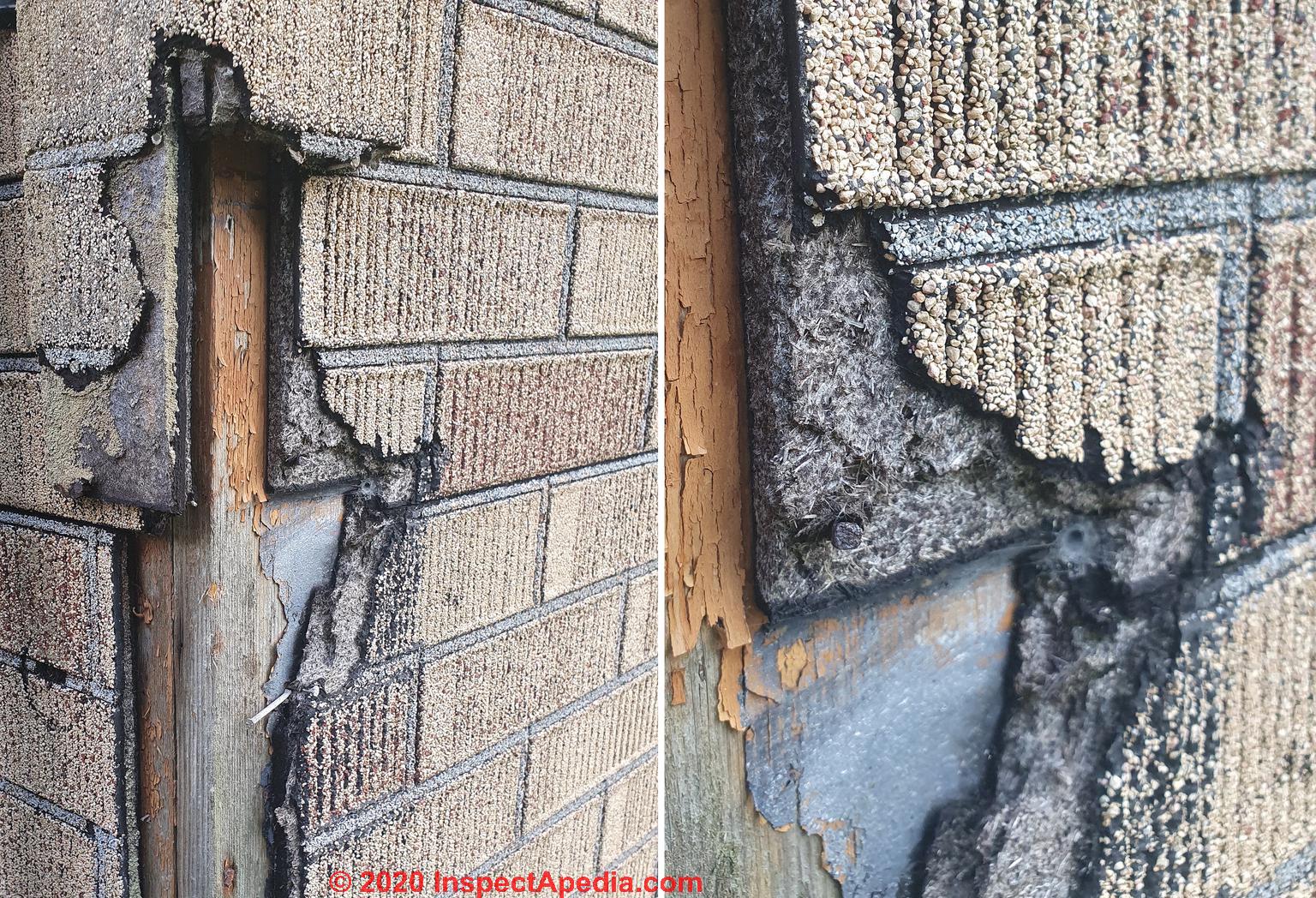 Thank you for the information on this site, it is very useful.
Thank you for the information on this site, it is very useful.
The photos [above] I attached to this comment are of yellow faux brick siding on a house in Sweden.
The tiles are 5x5 "bricks".
It looks very much like the InselBric siding you describe on this page.
I do not know who manufactured them or what the brand name was in Sweden.
I have not found any records of InselBric in Sweden. I have seen several smaller houses in the Swedish countryside with this yellow or red faux brick siding.
My question is, based on the photos, do you think this siding is based on wood-fiber or asbestos? - On 2020-12-19
by elvisdx - ...
Reply by (mod) - possible asbestos in Swedish asphalt-based siding
Thank you for the photos and question, Elvis.
Asphalt-based siding mounted on fiberboard was a widely-manufactured and distributed product for many years; to know absolutely whether or not your siding contains asbestos you'd need, of course, to have it tested or at least to know whose product it was.
In general, the wood-based fiberboard backer is not an asbestos product, but asbestos was often found in the asphalt-impregnated paper or felt backer that forms the base for the coloured mineral granules that form the brick "surface".
The material isn't highly friable and may not produce a measurable asbestos hazard until it's disturbed by grinding, chopping, sawing, demolition.
The research below may be helpful in making a further guess about the use of asbestos in asphalt products in Sweden.Asbestos in Asphalt Products in Sweden
- Greider, Harold W., and Marion F. Smith. Asbestos sheet material and method of manufacture [PDF] U.S. Patent 2,567,558, issued September 11, 1951. Filed by Philip Carey Manufacturing Co.,
Excerpt:
This invention relates to asbestos products and relates especially to products which comprise fibrous material containing asbestiform mineral fibers disposed in intimately contacting relation as by felting or other operation adapted to form a sheet or sheet-like body.
The asbestos products which find most extensive commercial use are asbestos sheet materials that are usually produced by water laying and that are generally referred to as asbestos paper or asbestos millboard, which is referred to herein generally as paper.
The bulk of the asbestiform mineral fiber that is used in asbestos paper usually runs from about to A in length, although the fiber that is supplied for paper making generally contains a considerable quantity of shorter fibers of varying lengths and may contain a portion of longer fibers.
The most generally accepted system of classification of asbestos fibers is that of the Quebec Asbestos Producers Association.
The asbestos fibers which are most commonly used for the manufacture of asbestos paper are those which range from Group 5 or paper classification to the Group '7 or shorts classification'of the Quebec Asbestos Producers Association, or mixtures thereof. - Järvholm, Bengt, and Anders Englund. "The impact of asbestos exposure in Swedish construction workers." American journal of industrial medicine 57, no. 1 (2014): 49-55.
- Westerholm, P., Remaéus, B., & Svartengren, M. (2017). THE TALE OF ASBESTOS IN SWEDEN 1972–1986—THE PATHWAY TO A NEAR-TOTAL BAN [PDF] International Journal of Environmental Research and Public Health, 14(11), 1433.
Abstract:
This paper provides a narrative of the national intervention strategy in Sweden aimed to restrict the industrial use of asbestos. For many years, asbestos was imported for widespread industrial use, resulting in large amounts throughout Swedish society.
In 1972, the whistle was blown in a Communist Party parliamentary motion describing asbestos as a health hazard and requesting action to prohibit its use. Although the motion was rejected, it initiated the extensive charting of asbestos sources on a tripartite basis, involving government agencies, and employer and trade-union organizations.
Restrictive asbestos management practices were enforced from July 1982.
The year 1985 saw the Government Asbestos Commission review, covering use-determining factors, international regulations, and assessments of cancer risks. The relative risks of chrysotile and amphibole were considered internationally (by the IARC), since chrysotile (a Canadian export) was regarded as unharmful in Canada at that time.
Prohibiting asbestos use resulted in its virtual disappearance as an import to Sweden from the early 1980s.
However, asbestos has undergone a transition from an occupational to a public-health hazard (although some work-related hazards, such as handling and disposal, remain).
The transition reflects the public’s exposure to existing stocks, in homes, workplaces, etc. Mesothelioma incidence has come to be regarded as an indicator of prevention effectiveness. View
Keywords: asbestos; asbestosis; lung cancer; mesothelioma; occupational hazard; public-health hazard; disease prevention
Asphalt Shingle Siding & Siding Backer Ingredients
Above and below: Fiberboard backer forms the base for the mineral-coated asphalt-based siding on this addition to a now-collapsed cabin in Pines, Michigan on Michigan's Upper Peninsula photographed by the author in November, 2023.
We think that a woodpecker made the many holes in this asphalt shingle siding.
Below is a close-up of a fragment of the siding shown just above. You can see the brown wood fibers that make up the fiberboard or hardboard backer for this siding.
More details about the structure above are
at DIAMOND WEDGE CUT LOG CABIN
Below: a close view of MDF fiberboard that was often sued as a backer for asphalt based, mineral granule-coated shingle siding.
The photo above shows a wood-fiber based backer board supporting asphalt-shingle siding. This photo was included in a question by reader Tim who asked if this was cement asbestos siding - it is not. His question and our reply are
at ASBESTOS CEMENT SIDING FAQs .
Below is a different type of asphalt building siding installed - or rather falling off of - a building on Main Street in Two Harbors Minnesota.
Below: our close-up photo shows an asphalt-impregnated backer board attached to the green asphalt shingle siding on this garage.
Asphalt Siding Defect Checklist
The two asphalt sheet siding photographs (below) show two defects often found on older buildings: falling siding where nails have been removed or lost (below left) and mechanical damage or tears in the siding (below-right).
The asphalt siding product shown at below right (produced on an all asphalt substrate similar to asphalt roof shingles) is different from the product at left (produced on a hardboard substrate). A closeup photograph of the hardboard substrate of this asphalt siding is shown at below-right.

Asphalt sheet siding - paper substrate is shown in the photographs just below.
You can see that this material may lose its granule coating to expose the asphalt-impregnated felt or paper base.
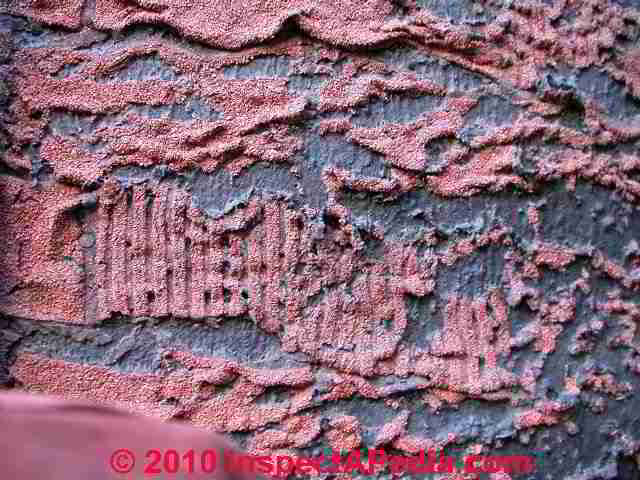
Our photo below shows that this hardboard-based asphalt building siding was installed over wood lath. We pose that the original building wall had been covered by stucco.
Asphalt Siding Repair, Removal, Siding Over
Loose asphalt wall siding that is otherwise in acceptable condition can be repaired by re-nailing it to the building.
Do not leave openings in the building cladding that permit leaks and water entry (such as shown in our photographs above) as you will be inviting a rot, wood destroying insect, or mold problem in the structure.
If money is short, a stopgap repair can be made by patching over with roll roofing or even a few roof shingles (and extra nails) as someone appears to have done in our photograph (left).
If large areas of the asphalt building siding are worn-through, the proper repair is to completely remove the material from the structure, inspect for and repair any structural damage, followed by installation of a new exterior wall covering.
What's the best way to side over InsulBrick Siding?
I was wondering what would be the best to deal with Inselbrick on the house we recently purchased.
Should we strap overtop and then put hardboard insulation then strap again and then put siding, or is it preferable just to strap it and put siding directly overtop. - On 2021-04-06 by Petra Reinert -
Reply by Inspectapedia Com Moderator - best way to install new siding over Inselbrick siding?
@Petra Reinert,
Typically we strap over existing siding when the walls are very uneven and we wouldn't have a good nail base.A problem with strapping over one or two times and installing new siding is that is your build out the wall you will find of the windows and doors receive as sunken into the building so you will want to build out the trim around all of those openings.
But of course there is the advantage of adding insulation to your building exterior
Precautions when removing old asphalt-based siding
Niagara Falls, NY -- any idea of special care I need to take when pulling this old siding off? - On 2023-02-22 by Brent -
I would love to be able to repair, but enough pieces are missing on this side of the house and I don't think you can find inselbric anymore. I don't know what product this is, but can you tell if there is asbestos? How expensive is this to replace given hazards?
Reply by InspectApedia Editor - asphalt building siding needs proper repair - don't try to match 60 year old asphalt siding sections
@Brent,
You won't find this type of fiberboard backed asphalt siding for sale today, so matching the damaged shingle sections is pretty unlikely.When I renovated homes like this we'd decide whether this was a complete re-siding job or, where the owner could not afford a costly siding replacement, whether it made sense to pull off all of the siding across the wall up to a height where good materials remained, replacing the removed materials with something that looked attractive but didn't try to match the original.
If large areas of the asphalt building siding are worn through, as is evident in your photos, the proper repair is to completely remove the material from the structure, inspect for and repair any structural damage, followed by installation of a new exterior wall covering.
With the missing siding areas, be sure to look for any water damage or entry that may indicate further inspection needed with potential repairs before residing occurs. Unaddressed, it could invite rot, insects, or mold.
As far as the asbestos question, please see
Does ASPHALT SIDING CONTAINS ASBESTOS?
where you'll see our response to a reader with a similar question.
Basically, it would be prudent to use appropriate dust control measures and to minimize the break-up of the material, and especially, to avoid using power saws. And there may be provincial or local municipal regulations that govern the demolition and removal of these materials.
Costs will vary by size of job, location, available contractors, and replacement material chosen. We recommend getting at least two, maybe three, estimates for the job to give you a realistic answer.
How to install vinyl siding over asphalt brick wall siding?
Can you install vinyl siding directly over vintage asphalt brick wall siding.? - On 2021-11-18 by Ron -
Reply by Inspectapedia Com Moderator
@Ron,
"Can" may be a bit broad;
I'd say that a better installation would use housewrap and furring strips to get a better wall, and you might need to build out window and door trim.
Can I Still Buy Replacement Asphalt-Based Exterior Siding?
Can you tell me where to buy faux asphalt brick siding? I live in New York. - N. verizon.net
Reply:
We have not found any of the U.S. asphalt product manufacturers such as GAF, Certainteed, Oldcastle who currently produce replacement copies of original asphalt-based building siding such as the brick-pattern you asked about.
The asphalt-based brick pattern exterior siding products found on some older buildings were generally produced by the same companies who produced asphalt-based roofing shingles.
Asphalt-based [roof shingle material on an organic (paper mat) or asphalt on hardboard] siding products were later supplanted by cement-asbestos siding-shingles, then aluminum siding and steel siding, then currently by vinyl siding.
We are doubtful you would find a current supplier of new asphalt siding products today, but I'll continue to look for such a source.
CONTACT us if you find a modern source, use, and building-code approval for asphalt-based faux-brick or similar pattern exterior siding.
Can I Use Roof Shingles for Exterior Siding?
Bad idea. We do not recommend using roof shingles for exterior siding, but if you are going to attempt that anyway, be sure that you follow the appropriate vertical and near-vertical nailing instructions for the roof shingles.
Otherwise you'll find them falling off of the building.
See SIDING ASPHALT ROOF SHINGLES on WALLS for details.
Research on the History of Asphalt Siding Products
- Arkansas Historic Preservation Program, ASPHALT ROOFING MATERIALS [PDF] published by the Arkansas Historic Preservation Program, retrieved 2017/10/08 original source: paragoninspects.com/articles/pdfs/exterior/ cladding/siding/asphalt/ asphalt-siding-materials-ahpp.pdf
- Beckman, Bernard C., "Composite siding." U.S. Patent 1,674,630, issued June 26, 1928. Assignee Beckman Dawson Roofing Company
- Cowan, Clarence Percival. "Cowan." U.S. Patent 1,655,494, issued January 10, 1928.
Excerpt:
My invention relates to improvements in roofing and siding construction and material for building purposes with more particular reference to prepared sheet surfacing material such as asphalt shingles and asphalt clap-boards and the object of the inventon is to devise an improved form of this lmaterial by means of which a superior construction may be obtained; ... - French, Henry, "Strip shingle." U.S. Patent 1,732,403, issued October 22, 1929.
Excerpts:
This invention has for its object to provide a new form of strip shingle which may be laid with others in overlapping rows to simulate laterally spaced individual roofing units, to provide a new and pleasing design or effect,... - Inselbric TRADEMARK [PDF] Inselbrick, US Trademark 71322368 (spelled with an "e" and without an ending "k") was registered on December 22, 1931 and has now expired. The Insulbrick trademark was first used in October 1931.
The name Inselbrick, is sometimes mis-written as "Insulbrick" (spelled with a "u") but that's a mistake.
Don't confuse Inselbrick asphalt siding with a completely different product, Insul-Brick, an insulating brick made of perlite and produced by Westblock Products, Inc.
The Insulbrick TRADEMARK [PDF] was published on September 9, 1986. - Jacobs, Frank Davis. "Roofing and siding material." U.S. Patent RE12475, issued April 24, 1906.
- Jacobs, Frank Davis. "Roofing and siding material." U.S. Patent 788,358, issued April 25, 1905.
- Milner, HISTORIC STRUCTURE REPORT for the BARNES HOUSE [PDF] (2004) Independent Hill Vicinity, Prince William County, Virginia, John Milner Associates, Inc., 5250 Cherokee Ave., Suite 410, Alexandria VA 22312, retrieved 2022/09/11 original source: https://eservice.pwcgov.org/library/digitallibrary/hsdw/B_Folder/BarnesHouse76-0473/pdfs/BarnesHouse-ArchA-0473.pdf
Page 17 in this report, Figure 6, shows that the Barnes House was later sided with Inselbric asphalt shingle siding.
Excerpt:
The entire house was covered with a layer of “Inselstone” siding (a variation on “Inselbrick” siding, a product manufactured by the Mastic Corporation of South Bend, Indiana beginning ... - Mullin, Thomas J., "Building material." U.S. Patent 1,362,888, issued December 21, 1920. Assignee Richardson Paper Company.
Excerpt:
My invention relates to material to be used in the construction of houses or other buildings as weatherproof fiber-board siding, to take the place of Wooden siding and weatherboarding for the outer wall covering for houses or buildings.
Wall board has been used for inside construction in houses as an iusidewall finish, but for outside wall construction, paper or fibrous material has not heretofore been made available.
It is accordingly the object of my invention to provide a material suitable for construction of outside walls, made of paper board, which is formed up with additional material and provided with a finish or outer layer or coating of materialwhich will make it available as an outside wall construction material. - Terpening, Frank W. "Roofing or siding." U.S. Patent 767,723, issued August 16, 1904. [Click to enlarge any image]
Excerpt:
My invention relates to that class of readymade rooting or siding which is composed of g a series of layers of impervious material rendered waterproof b the application of cei [sic] reference to roofing or siding sheets of this character in which is incorporated a layer of wire fabric to add strength and resistance to wear incident to the handling and service of the roofing or siding. ...
A designates sheets of vmy improved roofing or siding, each ot' which is provided .at one end with a lap surface B. rlhe rooting or siding sheets are each composed of a bottom layer 1 of fibrous wool-felt, onto which is laid a layer or coating 2 of cement, such as asphalt.
Above the layer 9. of asphalt is a layer or sheet 3 of wire fabric, which is surmounted by a layer or coating of cement, such as asphalt.
The layers'of` cement 2 and 4 permeate into the mes of the wire-fabric sheet 3 and furnish adhesion between said wire fabric and the bottom layer of wool-felt, thereby rendering the g sheet of rooting or siding intact throughout.
Onto the topmost layer 4 of cement Iapply a layer 5 of crushed granite, gravel, or other suitable granular material, which by embedding into the topmost layer of cement becomes an integral part of the rooting or siding sheets. - Powell, John R., and Benjamin G. Casler. "Roofing and siding material." U.S. Patent 1,114,032, issued October 20, 1914.
Above: Advertisement for an Inselbric sided four-year-old bungalow, Indianapolis Times, Indianapolis, 12 December 1945, courtesy of Hoosier State Chronicles archives.
- USDI, GET DOWN the Shovel and the Hoe! Cotton and Rice Farm History and Architecture in the Arkansas Delta,
1900-1955 [PDF] U.S. Department of the Interior, National Park Service, National, Register of Historic Places, retrieved 2022/09/11 original source: https://npgallery.nps.gov/NRHP/GetAsset/NRHP/64500901_text
Excerpt:
By the 1930s and 1940s USDA farm bulletins were suggesting that agricultural outbuildings be sided in rolled asphalt siding like Inselbric or Ashlar Stone.
- Welty, Peter P., "Siding and shingle strip for building purposes." U.S. Patent 1,515,530, issued November 11, 1924.
Excerpt:
This invention relates to siding or shingle strips for building purposes composed of flexible, water-proof material and adapted to be laid in overlapped courses, each strip constituting a member of the covering of the side of a building.
The main object of the invention is to provide a building strip of the class specified, constructed to simulate building units such as bricks and presenting, when a number of the strips are laid and overlapped,
a surface having the appearance of a brick wall, and to utilize in connection with these strips at inner and outer corner angles of the side portion of a building novel forms of supplemental strips having a particular specific construction,
to regularly continue the courses of the overlaid strips at the points indicated and preserve the continuity of the said strips at inner and outer angles.
7 A further object of the invention is to generally improve building strips of the character specified by forming the same from comparatively cheap material and subjecting the strips to treatment to render them water-proof,
and thereby economize in the cost of building materials with substantially the same degree of efficiency in service and wearing ability. - Also seeReferences or Citations at the end of this article
...
Reader Comments, Questions & Answers About The Article Above
Below you will find questions and answers previously posted on this page at its page bottom reader comment box.
Reader Q&A - also see RECOMMENDED ARTICLES & FAQs
Is asphalt building siding still sold?
I'm wondering if this still can be bought and where you can get it - On 2022-09-26 by Cindy coppins -
Can I find replacement sectfor light gray asphalt siding?
Funkymusic14 showed a photo of light gray asphalt siding, We have a house with that identical siding material.
Do you know of any place that might have replacement panels.
The size of each panel is approx. 1’ x 3’.x 1/2” thick with vertical striations. - On 2022-09-11 by Anonymous by private email
Reply by InspectApedia (mod) - generally no but ...
@Cindy coppins,
Several people have asked if asphalt siding is still sold -
To the best of our knowledge, the answer is and has been NO for some time. However we still find some people using asphalt products like roof shingles or roll roofing as a lower-cost expedient building siding covering.
Try again to post a photo using the Add Image button.
Reply by InspectApedia (mod) - sources for replacement sections of asphalt-based shingle siding
@Anonymous by private email,
Thanks for the question about sources for replacement sections of asphalt-based shingle siding.
While you could buy roll roofing and nail it to a wall, we don't recommend that approacy, so in general we answer thais question - as No.
If we find or any readers provide new information on a source for suitable or matching replacement asphalt-shingle siding or sheet siding or fiberboard-backed siding we'll be sure to include it here.
Can you spray paint asphalt based siding?
Can I spray paint ober this type siding ? - On 2022-06-30 by Linda -
Reply by InspectApedia-911 (mod) - Yes with care
@Linda,
Yes, we've definitely seen that done, often as an effort to extend the siding life. Discuss the paint choice with your paint supplier, and watch out for solvents that can soften or damage asphalt siding products.
Interlocking Asphalt-Saturated Wood Fiber Panels used indoors: safe?
Interlocking Asphalt-Saturated Wood Fiber Panels:
I believe this material was installed on the interior of my house, in the living room. Images attached for reference.
My house was built in 1930 in San Antonio, TX. Was this a common practice to use the panels on interiors? Do you know if it is safe for interior use from asbestos or other harmful ingredients ?
I have considered painting over it but suspect the paint would fleck off over time as the ceramic granules embedded in the asphalt come loose. Any suggestions?
Thank you for your very interesting article on historic building materials! - On 2021-06-02
by Rebecca Dietz
Reply by Inspectapedia Com Moderator - Is exterior asphalt siding used indoors safe?
@Rebecca Dietz,
It's not common to see an exterior siding material used indoors, but certainly within the scope of what people might think of to do in their building.
You could spray-paint the surfaces with a suitable sealant, followed by a finish coating.
At ASBESTOS ENCAPSULANTS & SEALERS - you will find some products that can be applied over asphalt materials like asphalt mastic and that would doubtless work on your asphalt-impregnated felt or fiberboard-backed siding used indoors.
Watch out: I like the look but I would want to
1. ask the local fire inspector if she considers this a fire-safe installation before doing any other renovations like painting or covering-over these walls
2. consider laminating a layer of drywall over all of the surfaces if you no longer want to look at asphalt siding; the advantages include a more-paintable surface, a fire safety improvement, and yet if someone comes along after us who wants to go back to a 1930's look, you've preserved that bit of the home's history.
(It's easy to remove drywall and just about impossible to remove paint on asphalt siding)I should make clear that asphalt siding exposed as a finish wall surface indoors may also violate local fire and safety codes.
Is this asphalt siding on a 1940 Illinois home asbestos?
Just wondering if this siding may have asbestos. The home was built in 1940 in IL [Photo above] - On 2020-02-19
by Marina -
Reply by (mod) - asphalt-shingle siding
Yes, Marina, that's an asphalt-based shingle siding. Some asphalt-impregnated (paper-based) siding materials contain asbestos.
You can see similar versions of that asphalt-based product above on this page. Asbestos may be in the asphalt impregnated felt backer of that siding.
Is asphalt based siding better than vinyl - is it acceptable?
My house was wrapped in rolled roofing, what do you think, it currently has cedar siding over it
my dad installed looks like roof shingles for siding on our house, around 1970, is this better than vinyl or other material.. is it acceptable to use? - On 2020-08-20 by sue -
Reply by (mod) -
Asphalt siding is perfectly acceptable on buildings and can be left alone as long as it's in good enough condition that the building isn't going to be damaged by leaks.
Asphalt based siding was most widely used as a cover-over on older wood clapboard buildings that needed paint, and as original siding covering on outbuildings built to a tighter budget.
About which is better, asphalt or vinyl? Both materials are usually serviceable if properly installed, and both have both durability or vulnerability risks and environmental hazard risks.
We discuss the question of asbestos in asphalt-based siding at
ASPHALT SIDING CONTAINS ASBESTOS?
but that's not the whole story. Also see this article that includes hazards to workers in the production of vinyl siding:
Rolled asbestos siding on grandfather's building - what's available today?
Try again; My grandfather had rolled asbestos siding on building fifty years. What similar product can be obtained today that is effective? - On 2020-04-23
by Ron Marshall -
Reply by (mod) -
There are no modern asphalt siding products that I've found currently for sale, nor would I recommend such products, though some people nail roofing shingles onto building walls (they're likely to fail).
Modern Fiber cement shingles (not the old asbestos-fiber-cement shingles) look a lot like Marina's product below, and are very durable.
Apologies, Ron, I'm not familiar with "rolled asbestos siding" - at least not by that exact term though there were certainly asphalt-based products sold in roll form for roofing that you might find on walls.
Pretty much all asbestos-cement board-like products were produced in a rolling mill such as that described by Mattison's 1911 patent.
And rollers imprinted a pattern on the siding.
But the popular or familiar name (to me) is asbestos-cement siding - on older buildings, usually in a shingle form, not in long boards until the 1950s (See Read 1958 cited in our Asbestos Cement Siding page)
Besides the asphalt-based siding described above on this page, take a look at
ASBESTOS CEMENT SIDING
and its modern replacement
SIDING, FIBER CEMENT - newer non-asbestos cement-based siding
So to be sure we're on the same "page", What are we talking about? A hard, rigid cementious shingle or board product or a more-flexible asphalt-based siding product?Or are you thinking about mineral granule faced roll roofing or similar asphalt products sometimes nailed on to walls?
...
Continue reading at ASPHALT ROOF SHINGLES on WALLS or select a topic from the closely-related articles below, or see the complete ARTICLE INDEX.
Or see ASPHALT SIDING FAQs questions & answers about asphalt based siding products that were posted originally at this page.
Or see these
Recommended Articles
- ASBESTOS CEMENT SIDING
- ASPHALT-ASBESTOS FELT
- ASPHALT ROOF MATERIAL ASBESTOS
- ASPHALT ROOF SHINGLES on WALLS
- PERMA-STONE EXTERIORS
- ROOFING MATERIALS, AGE, TYPES - includes history about asphalt roof shingles
- ROLL ROOFING, ASPHALT & SBS
Suggested citation for this web page
SIDING ASPHALT SHINGLE or SHEET at InspectApedia.com - online encyclopedia of building & environmental inspection, testing, diagnosis, repair, & problem prevention advice.
Or see this
INDEX to RELATED ARTICLES: ARTICLE INDEX to BUILDING SIDING
Or use the SEARCH BOX found below to Ask a Question or Search InspectApedia
Ask a Question or Search InspectApedia
Try the search box just below, or if you prefer, post a question or comment in the Comments box below and we will respond promptly.
Search the InspectApedia website
Note: appearance of your Comment below may be delayed: if your comment contains an image, photograph, web link, or text that looks to the software as if it might be a web link, your posting will appear after it has been approved by a moderator. Apologies for the delay.
Only one image can be added per comment but you can post as many comments, and therefore images, as you like.
You will not receive a notification when a response to your question has been posted.
Please bookmark this page to make it easy for you to check back for our response.
IF above you see "Comment Form is loading comments..." then COMMENT BOX - countable.ca / bawkbox.com IS NOT WORKING.
In any case you are welcome to send an email directly to us at InspectApedia.com at editor@inspectApedia.com
We'll reply to you directly. Please help us help you by noting, in your email, the URL of the InspectApedia page where you wanted to comment.
Citations & References
In addition to any citations in the article above, a full list is available on request.
- WEATHER RESISTIVE BARRIERS [PDF] U.S. Department of Energy, ", how to select and install housewrap and other types of weather resistive barriers
- Certainteed Weatherboard fiber cement siding and trim products - see certainteed.com/ or see certainteed.com/resources/sidingandtrimspecsheet.pdf
- In addition to citations & references found in this article, see the research citations given at the end of the related articles found at our suggested
CONTINUE READING or RECOMMENDED ARTICLES.
- Carson, Dunlop & Associates Ltd., 120 Carlton Street Suite 407, Toronto ON M5A 4K2. Tel: (416) 964-9415 1-800-268-7070 Email: info@carsondunlop.com. Alan Carson is a past president of ASHI, the American Society of Home Inspectors.
Thanks to Alan Carson and Bob Dunlop, for permission for InspectAPedia to use text excerpts from The HOME REFERENCE BOOK - the Encyclopedia of Homes and to use illustrations from The ILLUSTRATED HOME .
Carson Dunlop Associates provides extensive home inspection education and report writing material. In gratitude we provide links to tsome Carson Dunlop Associates products and services.



